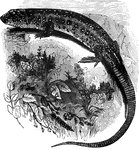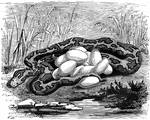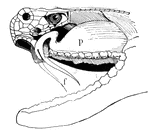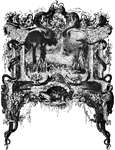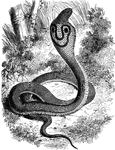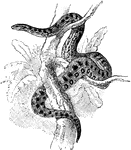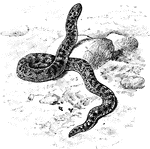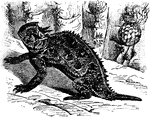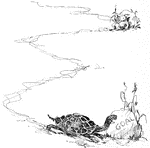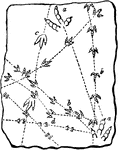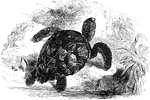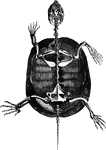
Yellow-Throated Plated Lizard
The Yellow-Throated Plated Lizard (Gerrhosaurus flavigularis) is a reptile in the Gerrhosauridae family…

Sand Lizard
"The Sand Lizard is a common European lizard, about seven inches long, of which the tail is four. Usual…

Variegated lizard
Found in Brazil and Guiana, the variegated lizard (or teguexin) preys on mice, frogs, and other small…
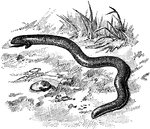
Four-Toed Worm Lizard
The four-toed worm lizard (Chirotes canaliculatus) is a reptile of the Amphisbaenidae family of usually…
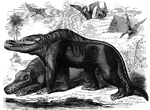
Megalosaurus and pterodactyls
A pair of megalosauruses, with a group of pterodactyls in the background.
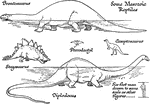
Mesozoic Age Reptiles
Some Mesozoic reptiles. Shown are the Brontosaurus, Stegosaurus, Pterodactyl, Camptosaurus, and the…

Mud-tortoise
Averaging six inches in length, the mud-tortoise is evenly distributed throughout the United States.

Musk-tortoise
The musk tortoise draws its namesake from its strong musky odor. It is found from Maine to Florida.

Douglas's phrynosoma
Commonly known as the horned toad, Douglas's phrynosoma was first discovered in Salt Lake Valley.
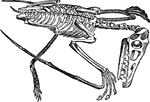
Pterodactyle skeleton
"So peculiar and strange is the structure of these animals, that the first specimen discovered was classed…

Raniceps Lyellii
This illustration represents a skeleton of another species of ancient amphibian reptiles.

Rattlesnake
"Rattlesnake is the English name for any species of the American genus Crotalus, the tail of which is…
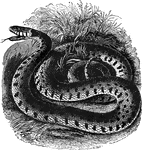
Common ring-snake
"The common snake of Europe... frequents woods, bogs, and other sheltered situations in the vicinity…
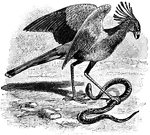
Secretary Bird
The Secretary Bird (Sagittarius serpentarius) is a bird of prey known for hunting snakes and other reptiles.
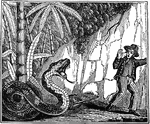
Escape from the Serpent of Ceylon
Miraculous escape from the royal serpent of Ceylon. Caption bellow illustration: "In dreadful anticipation…
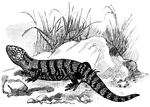
Skink, Giant Cyclodus
Cyclodus gigas. "They are harmless creatures, some inches long, natives mostly of warm countries, will…

Sandfish Skink
The sandfish (Scincus scincus) is a species of skink known for burrowing into the sand.
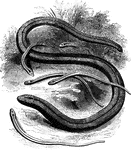
Slow-worm
Common in Europe, the slow-worm resembles a snake, but its internal structure is that of lizards.

Snake Head
"Snake's head. dv., Poison fangs; b., sheath of fang; l., tongue; rl., muscles of tongue." -Thomson,…

Golden Tree Snake
"Four to five feet long; color yellowishgray, cleaning with a pale golden hue, and dotted with whitish…

Mud Snake Slithering through Grass
The Mud Snake (Farancia abacura) is a reptile in the Colubridae family of colubrid snakes native to…
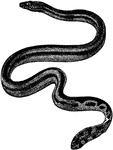
Sea Snake
The Sea Snake (Pelamis bicolor) is a tropical sea snake known for its black color on top and yellow…
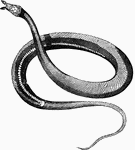
Herpeton tentaculatus
"The muzzle of H. tentaculatus is furnished with two soft prominences, covered with scales, the use…

Red-bellied terrapin
Common around New York and the surrounding regions, the red-bellied terrapin averages ten to seventeen…

Salt-water terrapin
The salt-water terrapin lives in salt or brackish water along the sea-coast, buying itself in the mud…

Smooth terrapin
The smooth terrapin is found from Rhode island southward along the eastern coast of the United States.
Matamata tortoise
Primarily nocturnal, the matamata tortoise of South America feeds on small reptiles and fish.

Soft-shelled tortoise
Found in the rivers and lakes of the western and southern United States, the soft-shelled tortoise feeds…

Spotted tortoise
Feeding primarily on worms and insects, the spotted tortoise averages three to four inches in length.

Tuatera
"Tuatera is a large lizard from New Zealand; apparently carnivorous, and in captivity are fed on raw…
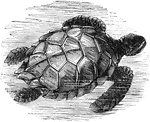
Green Turtle
The green turtle (Chelonia mydas) is a large sea turtle and the only member of the species Chelonia.

Hawksbill Turtle
The Hawksbill Turtle (Eretmochelys imbricata) is a species in the Chelonioidea of sea turtles.
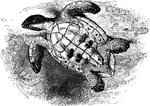
Imbricated turtle, overturned
An imbricated turtle, flipped onto its back, revealing its underbelly.

Leatherback turtle
The leatherback turtle (once known as the leathery turtle) is remarkable among turtles for its shell;…

Snapping turtle
Inhabiting freshwater areas of the United States, the snapping turtle feeds on frogs and fishes.

The Turtle
"The turtle, adapted for swimming and diving, the extremities being relatively larger than in the seal,…

Cross section of a viper head
Section of the head of a serpent. a, poison fangs; b, poison glands; c, conductor for the poison; d,…
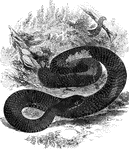
Black viper
Found in Europe from Sweden to the Medittanean Sea, the black viper is also the only venemous reptile…

Wood-terrapin
Sometimes referred to as the fresh-water terrapin, the wood-terrapin ranges from Canada to Pennsylvania.

Zonurus
Zonurus, the type genus of Acanthocercus, with several species from the S. and E. of Africa and Madagascar.
